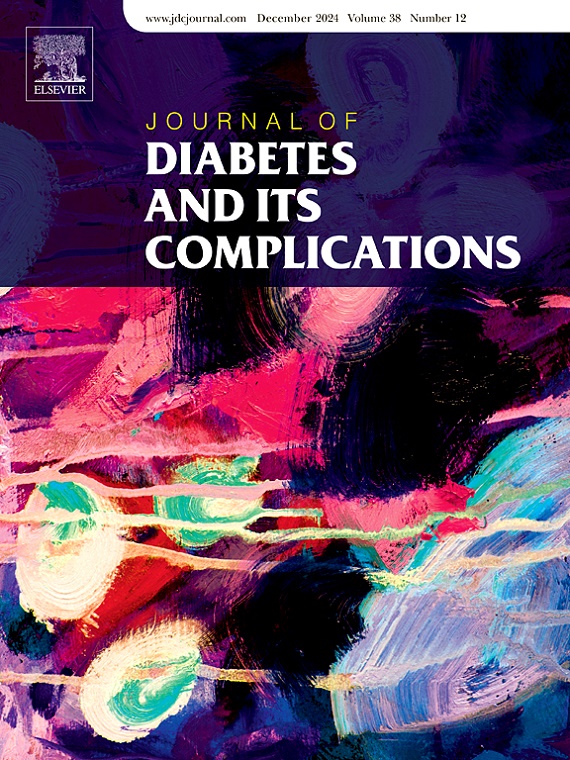Progressive improvements in patient-reported outcomes with the high-concentration capsaicin patch: A retrospective cohort study in patients with painful diabetic peripheral neuropathy (CASPAR study)
IF 3.1
3区 医学
Q3 ENDOCRINOLOGY & METABOLISM
引用次数: 0
Abstract
Objective
To assess long-term outcomes and tolerability associated with repeated topical high-concentration capsaicin patch (HCCP) treatments in painful diabetic peripheral neuropathy (pDPN).
Methods
CASPAR, a retrospective, non-interventional cohort study of HCCP for neuropathic pain, utilizes real-world data from the German Pain e-Registry. This analysis included 826 patients with pDPN of the hands, feet, or legs receiving ≥1 HCCP with ≥12 months of follow-up.
Results
Significant reductions in 24-ho average pain intensity (API) were seen at baseline to Month 3 (mean 57.5 vs 42.4). Successive treatments generated further improvements; these were lost upon HCCP discontinuation. Patients receiving four HCCPs had a mean API decrease from 59.0 (baseline) to 16.0 (Month 12). A ≥30 % API decrease was achieved at Month 12 in 98.9 %, 90.8 %, 67.7 %, and 22.0 % of patients receiving four, three, two, or one HCCP, respectively. Improvements were observed across sleep, QoL, mood, daily activities, and concomitant pain medication use, with the greatest benefits for patients receiving four HCCPs. Results were consistent across treatment locations. Safety and tolerability aligned with the well-established profile for HCCP, consisting of local application-site reactions.
Conclusion
HCCP is a non-systemic treatment for pDPN associated with increasing improvements in neuropathic pain, sleep, mood, and QoL with successive treatments.

高浓度辣椒素贴片对患者报告预后的进行性改善:一项对疼痛性糖尿病周围神经病变患者的回顾性队列研究(CASPAR研究)
目的评价反复局部高浓度辣椒素贴剂(HCCP)治疗疼痛性糖尿病周围神经病变(pDPN)的长期疗效和耐受性。scaspar是一项回顾性、非介入性队列研究,利用来自德国疼痛电子注册的真实数据,研究HCCP治疗神经性疼痛的疗效。该分析包括826例接受≥1 HCCP治疗的手、脚或腿部pDPN患者,随访≥12个月。结果从基线到第3个月,24小时平均疼痛强度(API)显著降低(平均57.5 vs 42.4)。连续治疗产生了进一步的改善;这些在HCCP停用后就丢失了。接受四种HCCPs治疗的患者的平均API从59.0(基线)下降到16.0(第12个月)。在接受4、3、2或1次HCCP治疗的患者中,98.9%、90.8%、67.7%和22.0%的患者在第12个月API下降≥30%。在睡眠、生活质量、情绪、日常活动和伴随止痛药使用方面观察到改善,接受四种hccp治疗的患者获益最大。不同治疗部位的结果是一致的。安全性和耐受性符合HCCP的既定概况,包括局部应用-现场反应。结论hccp是一种治疗pDPN的非全身性治疗方法,随着治疗的持续,其神经性疼痛、睡眠、情绪和生活质量的改善程度不断提高。
本文章由计算机程序翻译,如有差异,请以英文原文为准。
求助全文
约1分钟内获得全文
求助全文
来源期刊

Journal of diabetes and its complications
医学-内分泌学与代谢
CiteScore
5.90
自引率
3.30%
发文量
153
审稿时长
16 days
期刊介绍:
Journal of Diabetes and Its Complications (JDC) is a journal for health care practitioners and researchers, that publishes original research about the pathogenesis, diagnosis and management of diabetes mellitus and its complications. JDC also publishes articles on physiological and molecular aspects of glucose homeostasis.
The primary purpose of JDC is to act as a source of information usable by diabetes practitioners and researchers to increase their knowledge about mechanisms of diabetes and complications development, and promote better management of people with diabetes who are at risk for those complications.
Manuscripts submitted to JDC can report any aspect of basic, translational or clinical research as well as epidemiology. Topics can range broadly from early prediabetes to late-stage complicated diabetes. Topics relevant to basic/translational reports include pancreatic islet dysfunction and insulin resistance, altered adipose tissue function in diabetes, altered neuronal control of glucose homeostasis and mechanisms of drug action. Topics relevant to diabetic complications include diabetic retinopathy, neuropathy and nephropathy; peripheral vascular disease and coronary heart disease; gastrointestinal disorders, renal failure and impotence; and hypertension and hyperlipidemia.
 求助内容:
求助内容: 应助结果提醒方式:
应助结果提醒方式:


